Elektrum was invented by Ian James in October 2011, as part of a series of regularly-formed alphabets founded on phonetic principles. The name comes from the ancient alloy made of silver and gold, and hints at a mix of pre-classical epigraphy and modern phonology.
The consonants are all made with enclosed shapes, their frames matched to regions of articulation. Within the frames are various points, or rivets, or bumps, which identify the manner of articulation. Plosives are given forms which are reminiscent of plates being bolted hard to a surface. Devoicing is shown with a middle horizontal. The velar series ranges from /k/ to /q/ position, depending on adjacent vowels (front or back). The glottal region includes some "most rear" phonemes.
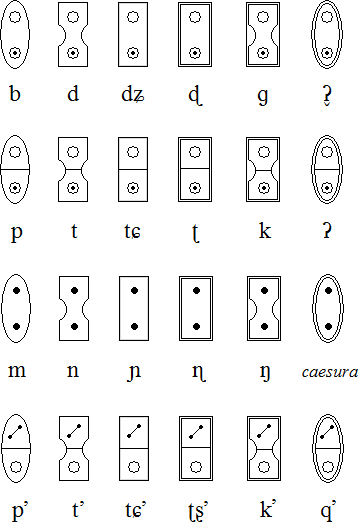
The fricatives are given simpler internals, since their sounds are freer, softer and continuous. Note the way the extra sibilants are used in the affricate situation. Semivowels have symbols related to their vowel form.
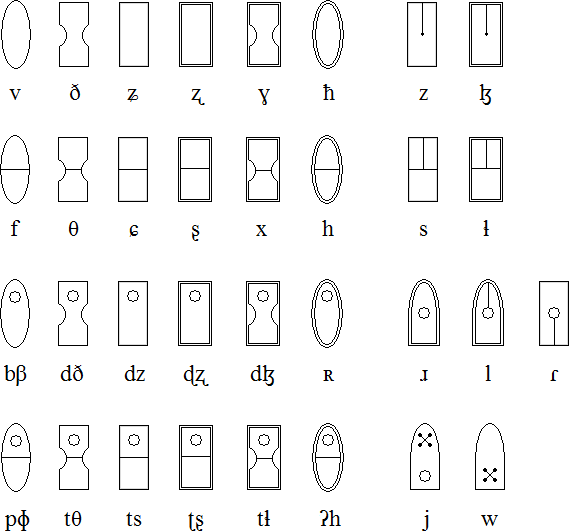
The vowels use point motifs similar to those found within consonants, but they have no enclosing frame (their sound is free of constriction). The tone suffixes may be used together to show rise and fall.
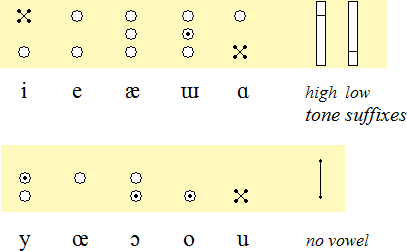
The shapes for the vowels are based on structures revealed in spectrograms of the spoken sounds – the grouping of their formant frequencies. For example, here are spectrogram patterns for the vowels [i], [æ] and [o], where the vertical axis shows frequency in Hz and the horizontal axis is time:
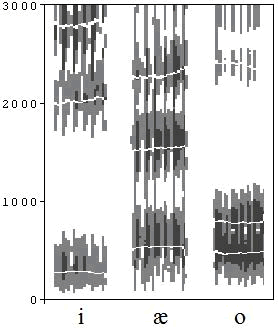
Mattias Persson has suggested various extensions to the system described above. They are realized without much fuss, using the basic elements already given: devoiced nasals, implosives, fricative ejectives and another semivowel. The "voiceless throat nasal" can represent a more definite caesura than the "voiced" equivalent. A nasalizer (coming after vowels) is made from the nasal internals.
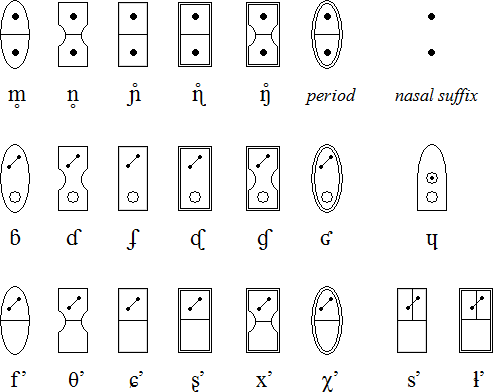
This is the first line of Shakespeare's sonnet 18, phonetically spelt out using Elektrum. (Ian commonly uses Shakespeare's poetry because of its relatively rich mix of phonemes.)

Shall I compare thee to a summer’s day?
Akkhara Muni, Amethyst, Bostani, Elektrum, Fontok, Klaekson-Zaen, Maui, New Akha, New Maori, New Mong, Pranish, SIGIL, Sigil Panel Script, Slinseng-Fi, Tengwar for Scottish Gaelic, Xylphika
See also: http://www.skyknowledge.com/orthographies.htm
Constructed scripts for: Ainu | Arabic | Chinese languages | Dutch | English | Hawaiian | Hungarian | Japanese | Korean | Lingala | Malay & Indonesian | Persian | Tagalog / Filipino | Russian | Sanskrit | Spanish | Taino | Turkish | Vietnamese | Welsh | Other natural languages | Colour-based scripts | Tactile scripts | Phonetic/universal scripts | Constructed scripts for constructed languages | Adaptations of existing alphabets | Fictional alphabets | Magical alphabets | A-Z index | How to submit a constructed script
[top]
You can support this site by Buying Me A Coffee, and if you like what you see on this page, you can use the buttons below to share it with people you know.

If you like this site and find it useful, you can support it by making a donation via PayPal or Patreon, or by contributing in other ways. Omniglot is how I make my living.
Note: all links on this site to Amazon.com, Amazon.co.uk
and Amazon.fr
are affiliate links. This means I earn a commission if you click on any of them and buy something. So by clicking on these links you can help to support this site.
[top]